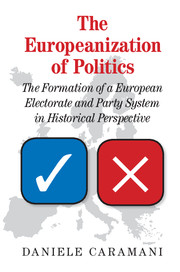 The Europeanization of Politics
The Europeanization of Politics Book contents
- Frontmatter
- Contents
- List of Figures
- List of Tables
- Preface and Acknowledgements
- List of Abbreviations
- Introduction: Electoral Integration in Europe
- Part I Framework
- Part II Analysis
- 3 Homogeneity: Convergence and Deviation in European Electoral Development, 1848–2012
- 4 Uniformity: Electoral Waves and Electoral Swings across Europe, 1848–2012
- 5 Correspondence: Overlapping versus Distinctive Electorates in National and European Elections, 1974–2012
- 6 Cohesion: Ideological Convergence within European Party Families, 1945–2009
- 7 Closure: The Europeanization of Cabinet and Coalition Politics, 1945–2009
- Part III Assessment
- Conclusion: Towards Europe-wide Representation
- Appendices
- References
- Index
6 - Cohesion: Ideological Convergence within European Party Families, 1945–2009
from Part II - Analysis
Published online by Cambridge University Press: 05 November 2015
- Frontmatter
- Contents
- List of Figures
- List of Tables
- Preface and Acknowledgements
- List of Abbreviations
- Introduction: Electoral Integration in Europe
- Part I Framework
- Part II Analysis
- 3 Homogeneity: Convergence and Deviation in European Electoral Development, 1848–2012
- 4 Uniformity: Electoral Waves and Electoral Swings across Europe, 1848–2012
- 5 Correspondence: Overlapping versus Distinctive Electorates in National and European Elections, 1974–2012
- 6 Cohesion: Ideological Convergence within European Party Families, 1945–2009
- 7 Closure: The Europeanization of Cabinet and Coalition Politics, 1945–2009
- Part III Assessment
- Conclusion: Towards Europe-wide Representation
- Appendices
- References
- Index
Summary
Introduction
Following three chapters on the Europeanization of party systems from the perspective of their “format”, the analysis in this and the next chapter turns to the perspective of their “contents”. One of the critiques made against studies of the national integration of parties and party systems is precisely that – in spite of similar levels of support and change over time – the content of the ideology and policy programmes of local “branches” are too different to consider them the “same” party. The names and symbols may be the same, but the local context imposes its constraints so that, say, the French Communist Party in Bretagne is a very different thing from the French Communist Party in the eastern banlieue of Paris.
The critique has been formulated against nationalization approaches, especially for some countries. In most cases, the strong centralization of party organizations at the national level and the fact that competition is national rather than local (or, more precisely, becomes national in the process of nationalization), makes cross-regional ideological variation rather unproblematic. At the European level the problem of “sameness” of parties of different countries bundled together in European party families, however, needs to be addressed in a systematic manner. The classification of national parties into families is the first step (seen in Chapter 2). The analysis of the ideological cohesiveness of parties belonging (or classified as belonging) to the same party family is the second step. This is the goal of the present chapter.
With Europeanization one observes homogenization of electoral support over time, similar cleavage structures and party systems across countries and across levels of governance, and simultaneity of change.
- Type
- Chapter
- Information
- The Europeanization of PoliticsThe Formation of a European Electorate and Party System in Historical Perspective, pp. 186 - 217Publisher: Cambridge University PressPrint publication year: 2015


